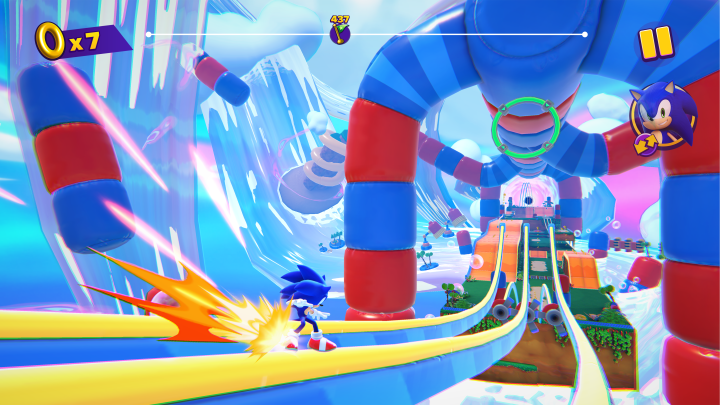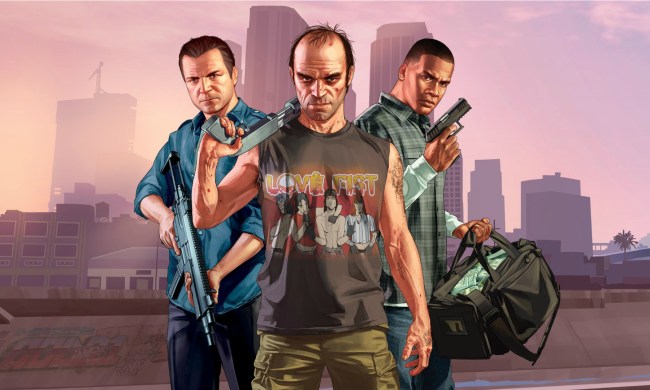When I was 9 years old, shortly after my cousin reintroduced me to Sonic Adventure 2: Battle on the GameCube, I had a dream that triggered my love for Sonic forever once I woke up. In that dream, Eggman kidnapped me for some heinous purpose, encasing me in a capsule for a weapon that could potentially destroy the planet. The details of that dream are fuzzy — most dreams are — but I recall Sonic rushing in to defeat Eggman and rescue me, putting an end to his evil plans once and for all.
Twenty years later, the trailer for Sonic Dream Team caught me by surprise with visuals reminiscent of Sonic Lost World and animated sequences (including a full opening cinematic, complete with Eggman having multiple arms just like the spider guy from Spirited Away) by none other than Sonic illustrator Tyson Heese. The title alone reminded me of the dream my 9-year-old self had so much, and I got the chance to relive it with my iPhone plugged into my Backbone controller (an experience I highly recommend, by the way).
Playing Sonic Dream Team isn’t a form of dream therapy for me (as weird as my dreams have been in the last few months) so much as it is a look into what made this title different from the other Sonic mobile games in developer Sega Hardlight’s portfolio. I played Sonic Dash and Sonic Forces: Speed Battle in the past, but they didn’t gel with me in the long run because of microtransactions and the monotony of endless running games. Sonic Dream Team removed both of those things, giving it a cohesive storyline, gameplay elements from past Sonic titles, and full-blown voice acting that make it a recipe for success for a longtime fan like me.
Musings of Sonic’s past
Part of what makes Sonic Dream Team work remarkably well is the gameplay elements that are inspired by some of the Sonic games of the last 20 years. Whether they were released on console or mobile, they served as muses during Sega Hardlight’s development of its Apple Arcade-exclusive title. The leading inspiration seems to be Sonic Heroes.
In Heroes, players can switch between three characters on the fly to get through obstacles suited to their abilities and type. Speed-type characters jump wall to wall, use Light Dash to go through Rings, deploy homing attacks on ground enemies, and Tornado Jump to climb up poles, power up flying contraptions, and put out flames. Flight classes fly from one point to another and shoot down flying enemies, and Power heroes punch through walls, larger enemies, cages, and catapult flaps.
In Dream Team, there’s only one character on-screen out of the two to six you can choose from at the beginning of each stage, depending on the stage’s layout, and you can switch to another character just by clicking on their icon at the top-right corner of the screen and picking them to accomplish what you need to do (though not all stages allow you to do so).

For example, if you’re playing as Sonic or Amy and you need to climb up a wall to get a Red Star Ring or Dream Orb shard, you can switch to either Knuckles or Rouge to scale them up — and not dig through dirt for once, which is a nice change of pace from their Sonic Adventure 2 gameplay. If you need to fly up to high areas, simply switch to Tails or Cream and they’ll hover up there with their tails or ears, respectively. It’s a great callback to a classic era of multicharacter Sonic games that expands on their experiments.
The other two muses are Sonic Lost World and Sonic Dash. Dream Team takes after Lost World in terms of its cartoony art style, platforming, and gravity-defying parkour. Seeing screenshots and clips of Scrambled Shores and Nightmare Maze on social media before the game’s release brought back memories of me playing Lost World on the Nintendo 3DS. Timed stages draw from Dash in that you have to boost your way through the pink-purple rings to buy yourself three more seconds in order to reach the goal before time runs out. You can use the same momentum in other stages and it will still feel exhilarating — so long as you don’t fall down the bottomless pit. It’s a great mix of styles from previous games fused together into one snappy platformer.
Dream-weaving a perfect story for mobile
Sonic Dream Team doesn’t just get gameplay right. Sega Hardlight dreamed up a fun storyline for the game with the help of IDW Sonic comic writer Ian Flynn, who also penned the script for Sonic Frontiers last year. The plot revolves around an ancient device called The Reverie, which can turn the dreams of anyone who has it into reality. Dr. Eggman, hell-bent on making his dreams of world domination come true as usual, discovers The Reverie and kidnaps Cream so that he could use her (and her Chao friend, Cheese) as a conduit to access the relic. Sonic and the gang attempt to rescue her, but The Reverie activates anyway and puts everyone in the room to sleep, and they all enter Eggman’s dream world and work together to put a stop to his evil plot from playing out in the real world with help from The Reverie’s guardian, Ariem, a ram whose name is a play on the sleep-cycle acronym REM.
The story plays out in cutscenes that are almost framed like comic book panels and in animated sequences that occur before boss fights (and once before the tutorial). The comic panel cutscenes are nearly reminiscent of the Sonic Storybook Series (you know, Sonic and the Secret Rings and Sonic and the Black Knight), except the pages are in 3D instead of illustrated like a storybook. Or in Flynn’s case, like a comic book.

Sega Hardlight and Flynn, along with Dan Rossati, have weaved the perfect story for Sonic Dream Team, creating a short adventure that feels like playing a Sonic game and reading a Sonic comic all at once. That’s great for any Sonic fan who’s falling behind on the comics (like myself, but I digress). Sonic Dream Team doesn’t require an internet connection to play either, like some other mobile titles, which makes it easy to get a new piece of story on the go, like flipping through a comic book page.
The voice acting moves the game’s story along at the good pace, which is a first for Sega Hardlight since its previous Sonic titles have no voice acting. My only qualms are the voice direction for Cream and Rouge. Cream’s voice sounds quite abrasive, but I suppose it’s fine since most 6-year-old children talk very loud. Rouge’s voice, on the other hand, sounds like the scene in The Lion King where Scar scratches his claws against the rock wall, nearly destroying Zazu’s small avian eardrums.
In my 20 years of being a Sonic fan — and now a professional expert on the franchise — I never thought I would play a Sonic game set in a dream world like that of the Blue Blur’s peer, NiGHTS, let alone a mobile Sonic game. Yet, here I am, writing up this very piece after playing through it on my iPhone 11. Sega pulled off a great surprise here, even if Dream Team‘s Apple Arcade exclusivity will limit who can enjoy it. From its 2000s-era teamwork systems to the sharp momentum from Sega Hardlight’s Sonic-themed endless runners, this adventure is a real dream come true for my 9-year-old self.
Sonic Dream Team is available now on Apple Arcade.



